Duolingo: come hanno fatto a migliorare il loro prodotto e a diventare l'app educativa #1
Prodotti iconici episodio 008

Ogni mattina, prima di andare a Salesflare, faccio la doccia, mi vesto, faccio i miei corsi quotidiani di Duolingo, faccio colazione e porto a spasso il cane.
Sì, Duolingo fa parte della mia routine quotidiana. E lo è per (probabilmente circa 10-20) milioni di altri utenti attivi quotidianamente.
È un'impresa davvero notevole per un'app che riesce a fare questo. Soprattutto se l'app riguarda l'apprendimento di una lingua straniera. Non sembra molto eccitante, vero? 😏
Duolingo rende effettivamente divertente l'apprendimento delle lingue, e forse anche leggermente divertente. 😬
È possibile? Come è possibile?
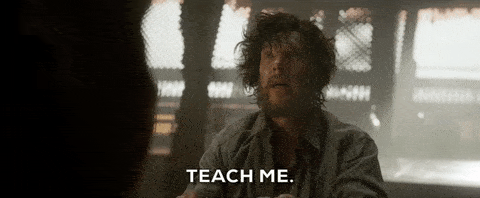
Entreremo nel merito del come dopo aver esplorato il perché. 👇
La missione di Duolingo: rendere l'educazione linguistica personalizzata, divertente e universalmente accessibile
Di fronte alle ineguaglianze dell'istruzione tradizionale, soprattutto nella sua città natale, Guatemala, il cofondatore di Duolingo, Luis von Ahn, ha sentito la necessità di cambiare qualcosa. 🧐
Ha pensato che, in particolare nei Paesi più poveri, l'istruzione fosse rotta. Chi ha i soldi può ricevere un'istruzione di alto livello, mentre chi non ha soldi sa a malapena leggere e scrivere. E per questo motivo, non fanno soldi. Un circolo vizioso. 😔
Luis ha visto che esisteva un software per l'apprendimento delle lingue, come Rosetta Stone, ma il suo costo era proibitivo e quindi non aiutava a colmare il divario educativo.
È allora che è nato Duolingo, che promette a tutti l'apprendimento gratuito delle lingue. Accessibile a tutti coloro che vogliono imparare. ✨

Sulla base della sua missione, Duolingo ha attirato da allora utenti, dipendenti e investitori.
Naturalmente, per sopravvivere, Duolingo ha dovuto fare soldi in qualche modo. La scelta si basa su annunci, abbonamenti mensili che rimuovono gli annunci, acquisti in-app e il Duolingo English Test.
Oltre a renderlo universalmente accessibile, si sono concentrati sul rendere l'apprendimento personalizzato e divertente. 😍
Credevano che il software fosse perfettamente adatto a offrire un'esperienza personalizzata a ogni singolo studente di lingue.
E che l'apprendimento delle lingue dovrebbe essere meno noioso e più simile a un gioco divertente. Altrimenti chi vorrebbe tornare su un'applicazione per l'apprendimento delle lingue? 😉
Un'organizzazione di prodotto, focalizzata su design e dati
Universalmente accessibile, personalizzato e divertente. Suona bene. 👍
Come si fa a far sì che ciò accada?
La strategia di Duolingo consiste nel migliorare costantemente ildesign dei prodotti per stimolare il giusto comportamento degli utenti sulla base di dati. 👈
E lo pensano davvero. Più di 3/4 del team di Duolingo si occupa di ingegneria, design, prodotti o ricerca.

Questo è in netto contrasto con l'altro grande software per l'apprendimento delle lingue: Rosetta Stone. Solo poco più di 1/4 del suo team lavora in questi stessi settori (in base ai dati di LinkedIn Premium).
È la classica battaglia: organizzazione del prodotto contro organizzazione marketing-vendita.
E se si analizza la crescita di Rosetta Stone rispetto a Duolingo, la strategia di prodotto di Duolingo si dimostra superiore. 💪
Secondo Google, ottengono un maggiore interesse nelle ricerche.

E fanno crescere la loro azienda a un tasso molto più alto, secondo LinkedIn.
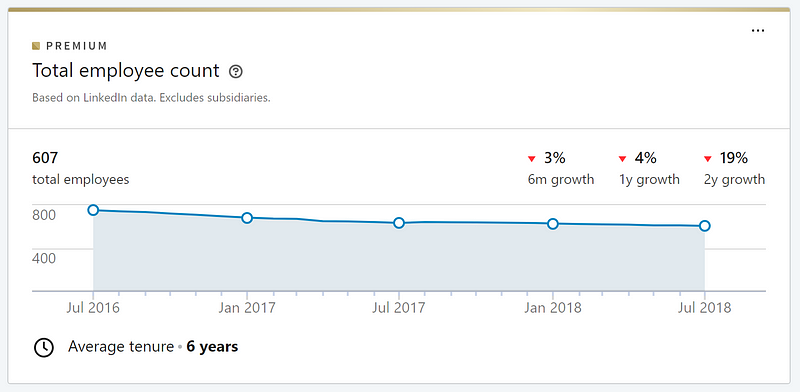
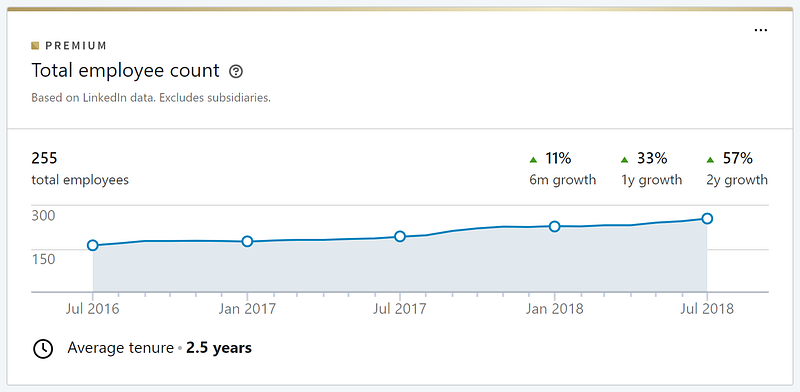
Da matematico e informatico, il cofondatore di Duolingo Luis von Ahn non ha sempre creduto nel potere del product design.
Ma ora, quando gli si chiede quale sia il libro che gli ha cambiato la vita, risponde che è "The Design of Everyday Things" di Don Norman. Da quando ha letto il libro, è ossessionato da come vengono progettati i prodotti.
Essendo un team guidato da scienziati, Duolingo non si limita a migliorare il design sulla base di sensazioni personali. Utilizza i dati come stella polare. 🌟
Tre obiettivi, tre team Duolingo: apprendimento, crescita e monetizzazione
Per Duolingo, il diritto comportamento dell'utente significa:
- Apprendimento: le persone hanno più successo nell'apprendimento
- Crescita: più persone imparano
- Monetizzazione: maggiori entrate per sostenere la causa
Ecco perché Duolingo ha deciso di creare tre team per lavorare su questi tre obiettivi: un team di apprendimento, un team di crescita e un team di monetizzazione. 💡
Ogni team è responsabile del miglioramento delle metriche legate al proprio obiettivo specifico, organizzando esperimenti di prodotto.
5 Esperimenti sui prodotti Duolingo
La homepage di Duolingo dà già una buona idea di alcuni dei modi in cui il prodotto è costruito per stimolare il giusto comportamento dell'utente.

Il fatto che il software non utilizzi più i "cuori" e non parli di badge o del suo coach in-app "Duo", è un chiaro esempio di come Duolingo esegua rapidamente e spesso esperimenti per migliorare il prodotto.
Ecco 5 esperimenti degni di nota e l'impatto concreto che hanno avuto. 👇
1/ Ritardo nell'iscrizione
Il team di Duolingo ha scoperto che, consentendo agli utenti di iscriversi più tardi e di sperimentare prima alcune lezioni di Duolingo, è stato possibile aumentare il numero di utenti attivi giornalieri di 20%. 💥
Sulla base di questi esperimenti, il team ha introdotto i "soft walls". Si tratta di pagine opzionali che chiedono alle persone di iscriversi, ma che consentono loro di premere "Più tardi".
Infine, dopo una serie di lezioni, c'è un "hard wall" che richiede agli utenti di iscriversi. Il team ha scoperto che le prestazioni di questo muro sono state migliorate anche dalla presenza dei "muri morbidi", poiché gli utenti erano già pronti a iscriversi.
Nel processo di introduzione dei "muri morbidi", Duolingo ha commesso un errore che ha poi dovuto correggere: il team ha creato un grande pulsante rosso "Cancella i miei progressi". In seguito si è scoperto che questo pulsante in realtà invitava le persone a cliccarci sopra, invece di spaventarle. Sostituendolo poi con un pulsante grigio "Più tardi" le prestazioni sono aumentate.
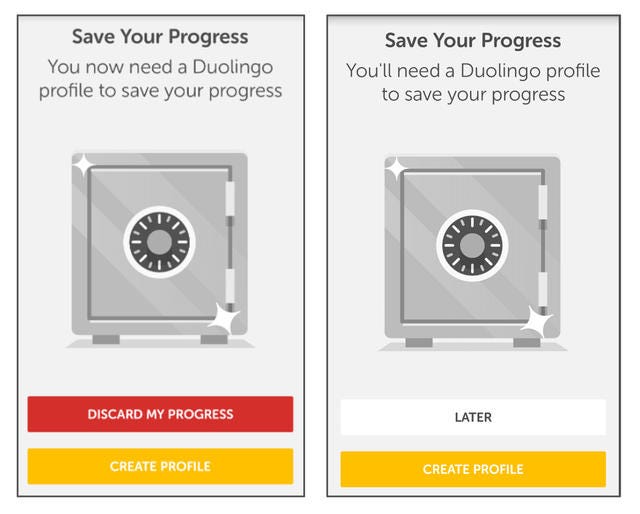
Il team è riuscito a migliorare gli utenti attivi giornalieri di altri 8,2% con questi esperimenti successivi. Una cifra estremamente significativa. 😲
2/ Streak
Un altro aspetto importante del prodotto che il team di Duolingo ha sperimentato molto è il concetto di "striscia", mutuato dall'industria dei giochi.
Ciò significa che se un utente usa Duolingo per x giorni consecutivi, accumula una striscia. Gli utenti iniziano a sentirsi investiti e cercano di non interrompere questa striscia. In questo modo ricompensano la perseveranza. 🎁
Personalmente sono in striscia da 152 giorni e questa è la mia migliore motivazione per andare avanti. 💪

Il potere della striscia sulla conservazione è così forte che il team di Duolingo dedica molto tempo alla sua ottimizzazione. In particolare, rende più difficile perdere la striscia e più facile recuperarla con alcuni esercizi.
Il team ha introdotto gli "amuleti del fine settimana", la "riparazione delle strisce", il "congelamento delle strisce", ... in modo che le persone possano rimediare ai loro fallimenti umani. La sola introduzione dell'amuleto è stata responsabile di un aumento del 4% della ritenzione a 14 giorni. ✨
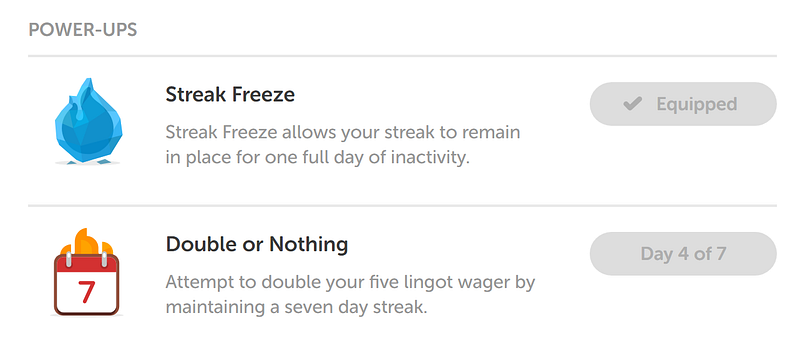
3/ Notifiche
Inoltre, il team è stato in grado di migliorare le conversioni rispetto alle notifiche di circa 5% solo modificando la copia e testando diversi orari.
Uno dei più famosi esperimenti di copy è questa notifica aggressiva passiva: "Ciao! Sono Duo. Questi promemoria non sembrano funzionare. Per ora smettiamo di inviarli".
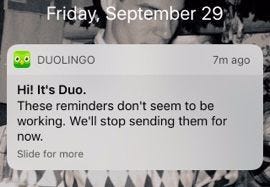
In termini di tempistica, il team ha scoperto che 23,5 ore dopo la sessione di apprendimento passata era il momento migliore per ricordare alle persone di fare la sessione successiva, poiché le persone di solito imparano nello stesso momento della giornata.
4/ Distintivi
Un classico aspetto di gamification aggiunto dal team di Duolingo sono i badge.
I badge mostrano il comportamento dell'utente che Duolingo vuole promuovere. Tra questi: spendere lingotti (la moneta virtuale di Duolingo), iniziare scommesse, mantenere strisce, imparare durante i fine settimana, essere attivi nei club linguistici integrati di Duolingo, ...
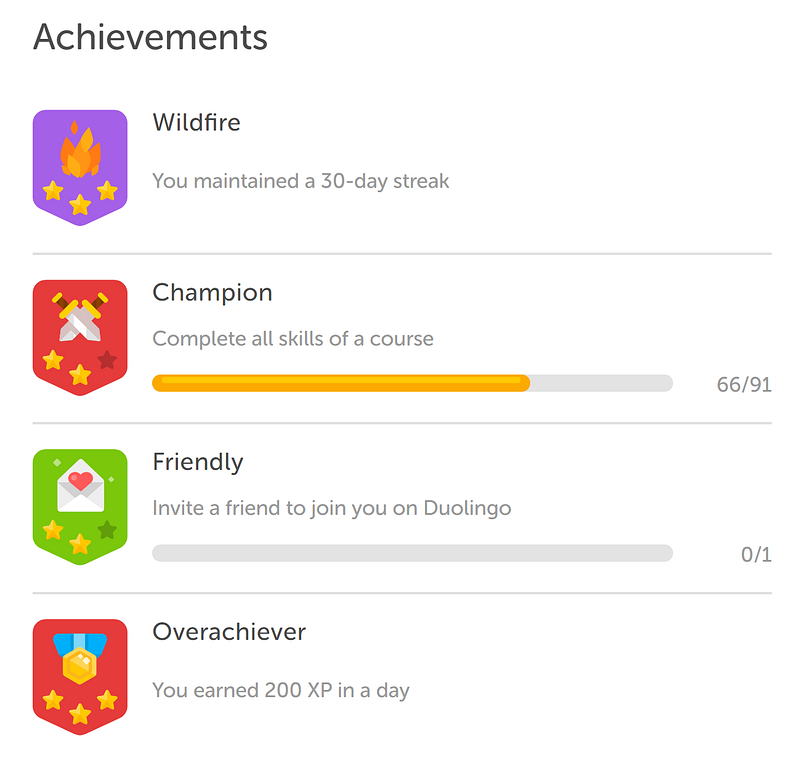
La prima versione del sistema di badge da sola (anche senza i livelli di badge, cioè le stelle nello screenshot qui sopra) ha già aumentato gli utenti attivi giornalieri di 2,4%.
Ma ha anche stimolato un comportamento positivo molto specifico: ha aumentato gli acquisti dal negozio di Duolingo di 13% e ha aumentato la quantità di amici aggiunti di 116%.
5/ Allenatore in-app
Uno degli esperimenti più controversi all'interno del team di Duolingo è stata l'introduzione dell'allenatore in-app chiamato "Duo", la mascotte gufo di supporto. Alcuni membri del team l'hanno amata, altri l'hanno trovata fastidiosa.

A parte i gusti personali, la stella guida dei dati ha sempre ragione. 🌟
L'introduzione di Duo ha migliorato la retention a 14 giorni del 7,2%. Un successo quasi pari a quello dei badge. 🚀
Duolingo continua a mettere in fila esperimenti di prodotto
Duolingo sa che fermare il processo di miglioramento significa restare fermi. E restare fermi significa alla fine fallire.
D'altra parte, c'è una molteplicità infinita di esperimenti sui prodotti che si possono fare e avviare esperimenti senza pensare può rivelarsi una totale perdita di tempo.
Ecco perché il team di Duolingo tiene diligentemente traccia di tutti i possibili esperimenti di prodotto, li classifica e li pianifica di conseguenza.
A tenere tracciaDuolingo aggiunge l'elenco degli esperimenti a JIRA. (Nota: utilizzare quello che funziona. Noi di Salesflare usiamo GitHub invece di JIRA).
Per prioritizzare, hanno 2 semplici regole di priorità costi-benefici:
- Qual è il impatto potenziale dell'esperimento? Il team di Duolingo ha persino deciso che gli esperimenti con un impatto inferiore a 1% non valgono la pena.
- Quanto tempo ci vorrà per eseguire gli esperimenti?
Infine, quando pianificano, scelgono coerentemente di non ignorare i piccoli esperimenti a favore di quelli grandi. Credono che sia la successione di un'enorme quantità di piccoli miglioramenti a portare a grandi risultati.
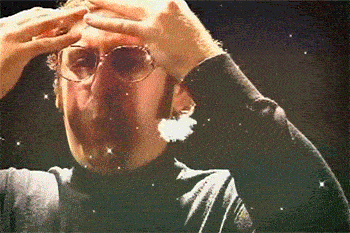
Brava, Duolingo! 🙌 Continua a portare avanti la tua fantastica missione.
Il team Salesflare vi ama. 😍
Volete scoprire altri prodotti iconici? Leggete l'intera serie qui! 📲

Speriamo che questo post vi sia piaciuto. Se vi è piaciuto, spargete la voce!
👉 Potete seguire @salesflare su Twitter, Facebook e LinkedIn.
Ultimo aggiornamento:
- 7 Migliori CRM per Mac nel 2025 - 19 Settembre 2025
- 7 Migliori alternative al CRM di HubSpot nel 2025 - 17 Settembre 2025
- 7 Migliori alternative a Pipedrive nel 2025 - 16 Settembre 2025